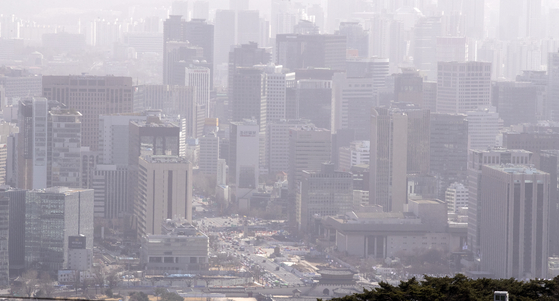
On the afternoon of the 16th, the downtown of Seoul viewed from the Seongbuk Observation Deck in Jongno-gu, Seoul, is blurred due to the influence of yellow dust. Reporter Lim Hyun-dong
Seoul is the’Waravall City’ in 2030 that citizens want
The area that Seoul citizens are most satisfied with in Seoul is public transportation infrastructure. The most unsatisfactory sectors were fine dust and air pollution. Improvements in this area were selected as the most necessary competency for 10 years later.
Published’Seoul Future Report 2030′
The Seoul Institute of Technology released the opinions of 100 experts and 1,000 Seoul citizens surveyed for the publication of the’Seoul Future Report 2030′ on the 19th. This report contains a blueprint for technology policy for the next 10 years, focusing on five studies, including major urban issues, future scenarios for Seoul, urban infrastructure, safety and disaster prevention, living environment, smart city, and climate environment.
![[자료 서울시]](https://i0.wp.com/pds.joins.com/news/component/htmlphoto_mmdata/202103/19/0c13e669-9d0d-4777-963f-9912f3e08c15.jpg?w=560&ssl=1)
[자료 서울시]
In the survey, Seoul citizens answered that they were satisfied with Seoul in the order of public transportation infrastructure (87.5 points), shopping and commercial facilities (82.7 points), and medical facilities (80.6 points). On the contrary, satisfaction with fine dust and air pollution (32.8 points), securing parking lots (43.6 points), and balanced development between autonomous districts (49.1 points) was the lowest.
The most necessary competencies for the future were the improvement of the natural and living environment (81.7 points), such as air and water quality, followed by the preparation of countermeasures after the novel coronavirus infection (Corona 19) (81.2 points), and job creation (78.2 points). It was in the order of repair of old public facilities (78 points).
![Satisfaction level of Seoul citizens. As of September 2020. [자료 서울시]](https://i0.wp.com/pds.joins.com/news/component/htmlphoto_mmdata/202103/19/dae15797-19ac-4a8b-b7bf-6bece02ea690.jpg?w=560&ssl=1)
Satisfaction level of Seoul citizens. As of September 2020. [자료 서울시]
The most necessary competence after 10 years of’improving the atmosphere’
The number 1 reason for living in Seoul was the workplace and accessibility (27.1%). It was followed by family, relatives, and acquaintances living in Seoul (25.9%) and the convenience of public transportation such as subways and buses (22.4%). The average satisfaction level for living in Seoul was 74.8 points. The satisfaction of women is higher than that of men, and the Southeast region is the most satisfied among the regions.
The vision of the future of Seoul in 2030 that citizens most desired was a city (21.7%) where they could enjoy a balance between work and life. Next, smart cities to which advanced technology was applied (13.1%), followed by cities with various cultural features and foundations (10.8%). This survey was conducted on September 4-8 last year, targeting Seoul citizens in their 10s to 60s.
![The reason for living in Seoul. [자료 서울시]](https://i0.wp.com/pds.joins.com/news/component/htmlphoto_mmdata/202103/19/d924aa33-00da-42a6-941c-0b2871a07bf3.jpg?w=560&ssl=1)
The reason for living in Seoul. [자료 서울시]
100 experts, including Professor Seong-hee Kim and Chang-Ho Choi, head of the Korea Institute of Construction Technology, participated in this study. Experts believe that green energy technology will have the highest utilization value in Seoul in the future. Big data analysis, future eco-friendly cars, and smart healthcare followed. Ten years later, he cited population, climate change, resource circulation, infrastructure, and infectious diseases.
The Seoul Future Report 2030, composed of six volumes by research field, is scheduled to be published on the 31st. It can be seen at the Seoul Library from April. On the 23rd, the researcher opened the’Technology-Based Urban Infrastructure Future Seoul Policy Forum’ at the Seoul Metropolitan Assembly Hall.
Reporter Choi Eun-kyung [email protected]
![]()
